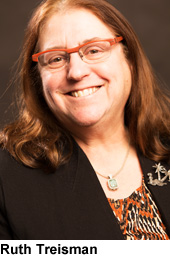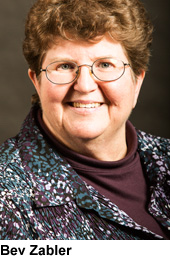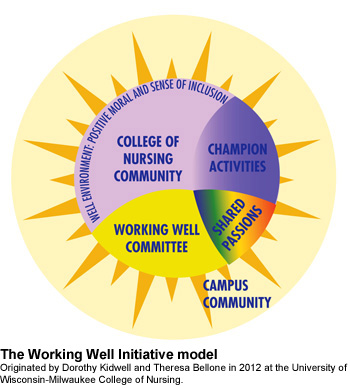Not bad for less than $200 a year!

Getting together and celebrating life as a community go a long way toward making the work environment more enjoyable, improving morale, and fostering inclusivity.
 In 2016, the American Association of Critical-Care Nurses articulated standards for healthy work environments. In 2017, the American Nurses Association launched its Year of the Healthy Nurse campaign, focusing on health, safety, and wellness of nurses and promoting relevant resources and activities. That initial one-year initiative has since transitioned into the ongoing Healthy Nurse, Healthy Nation program.
In 2016, the American Association of Critical-Care Nurses articulated standards for healthy work environments. In 2017, the American Nurses Association launched its Year of the Healthy Nurse campaign, focusing on health, safety, and wellness of nurses and promoting relevant resources and activities. That initial one-year initiative has since transitioned into the ongoing Healthy Nurse, Healthy Nation program.
Concurrently, in primary care, a white paper published by the U.S. Department of Health & Human Services’ Agency for Healthcare Research and Quality included “improved work life for staff” among its proposed quality metrics. A paper by two physicians that was subtitled “Care of the Patient Requires Care of the Provider” suggested the latter should be measured. All of the above focus on stress management and reduction of burnout and compassion fatigue, which enhance professional well-being.
 Promoting a positive work environment has been a focus of the College of Nursing at the University of Wisconsin-Milwaukee (UWM) for more than 15 years. During that time, we have developed and implemented a successful strategy for promoting a healthy academic work environment. Initially, the journey toward a low-cost workable model was bumpy, but we have since made significant progress.
Promoting a positive work environment has been a focus of the College of Nursing at the University of Wisconsin-Milwaukee (UWM) for more than 15 years. During that time, we have developed and implemented a successful strategy for promoting a healthy academic work environment. Initially, the journey toward a low-cost workable model was bumpy, but we have since made significant progress.
Starting out
In 2001, leaders in the College of Nursing actively engaged faculty and staff members in helping promote a positive climate in their workplace by inaugurating a Climate Committee. They cited evidence, emerging at that time, that positive work environments foster productivity, improve profit, and lead to less employee turnover and greater retention (Harter, Schmidt, & Keyes, 2003). People who volunteered to serve on the committee were charged with creating and executing college-wide “feel good” events.
Five years later, the Climate Committee’s climate had worsened. Despite efforts to recruit new volunteers, the same people were hefting the load. For the next four years, committee members employed—unsuccessfully—multiple strategies to engage more staff participation.
Starting over
 As morale in the UWM College of Nursing was hitting a low, two innovative committee members proposed to the dean a “Working Well Initiative” (WWI). The new approach, which involved forming a new committee with equitable representation of faculty, staff, and students, sought to improve workplace wellness via contributions of a college community that works well together. Employing a formalized participation process, the committee encouraged stakeholders to collaborate in creation of a healthier work environment while increasing opportunities for increased faculty and staff interaction.
As morale in the UWM College of Nursing was hitting a low, two innovative committee members proposed to the dean a “Working Well Initiative” (WWI). The new approach, which involved forming a new committee with equitable representation of faculty, staff, and students, sought to improve workplace wellness via contributions of a college community that works well together. Employing a formalized participation process, the committee encouraged stakeholders to collaborate in creation of a healthier work environment while increasing opportunities for increased faculty and staff interaction.
To make the proposed changes operational, the dean appointed a task force that spent the first year developing the WWI model and a process for vetting activity proposals. College community participants who had talents or skills and a passion for sharing them were recruited as “champions.” One example of an activity is monthly recognition at staff meetings of those celebrating birthdays. The champion, who is a graphic artist and talented musician, honors celebrants in passionate song synced with relevant projected images.
The goal is to foster positive morale and a sense of inclusivity within the UWM College of Nursing community. In doing so, the Working Well Initiative supports the college’s strategic plan and the university’s campus-wide Workplace Wellbeing initiative. It also serves as a clearinghouse for planning, prioritizing, and implementing activities that support working together to achieve the College of Nursing’s mission and vision. Activities support the domains of a Well Workplace Environment (WWE) and Positive Workplace Relations (PWR). The acronym PWR reminds us that a healthy workplace powers positive relationships.
Initially, implementation of WWI started with an ad hoc committee operating under a College of Nursing-codified standing committee with volunteer participants representing all position types. The ad hoc committee has since become a subcommittee with an annual activities budget of no more than $200.
Although the WWI model requires few monetary resources, it promotes a positive work environment that engages all workers. In 2015, the College of Nursing was recognized as a campus leader in developing a positive and healthy workplace environment. Since then, although subcommittee leadership and membership have changed, the model and the processes have not, and champions continue to share their passions.
We all have passions to share
The WWI subcommittee now meets for one hour five times a year. During these get-togethers, we review champion proposals for new activities and events. An event proposal, for example, describes the event and provides an estimate of how much it will cost. Subcommittee members determine which domain it best supports—WWE or PWR. If an event is approved, the champion spearheads it, and a focus area coordinator provides additional oversight and support. Examples of champion-promoted activities that support each of these domains are outlined below.
Well Workplace Environment (WWE)
Climate: Celebration or socialization events—such as potlucks, retirement parties, and birthday recognition—often highlight cultural diversity of participants to increase understanding of practices and traditions.
Special events: Examples include art sales to benefit nursing projects and themed events related, for example, to Black History Month. When possible, coordination with campus-wide events encourages attendance.
Activities related to the seven dimensions of wellness (social, physical, environmental, career, intellectual, emotional, and spiritual): Activities include lunch walking, information dissemination, promotion of healthy eating habits, chair massages, meditation sessions, and listening to inspirational speakers.
Positive Workplace Relations (PWR)
Promote collegiality of faculty and staff: Examples include monthly birthday celebrations, college community member recognition postings, and annual acknowledgment of champions.
Coordinate group challenges: Activities such as wellness contests and establishing teams for benefit walks and runs.
Encourage team spirit: Examples include setting up team-building events and inviting motivational speakers.
College-wide communication: Includes newsletter production and coordination of email messaging.
Align faculty, staff, and student relationships with campus-wide Workplace Wellbeing program: Examples include providing nourishing snacks at exam time, setting up quiet study areas, and so on.
Working Well is working well
Overall, the College of Nursing community is pleased with WWI. Faculty and staff continue to volunteer their service on the subcommittee, and champions continue to submit activity proposals. In a recent academic year, more than half of those eligible participated.
The University of Wisconsin-Milwaukee College of Nursing continues to be a place we want to work. Providing time to network, socialize, and participate in self-care activities improves resilience, and opportunities to share passions, interests, and talents reenergize us. Building an inclusive community encourages new connections and makes our work more meaningful. Because of our Working Well Initiative, we work well together and are thriving in our academic setting! RNL
Ruth A. Treisman, MSN, ARNP-BC, is a clinical assistant professor at the University of Wisconsin-Milwaukee College of Nursing in Milwaukee, Wisconsin, USA. Bev Zabler, PhD, RN, is also a clinical assistant professor at UWM College of Nursing.
Editor’s note: Ruth Treisman presented Enhancing Academic Workplace Well-Being: The University of Wisconsin-Milwaukee College of Nursing on Saturday, 23 February 2019, at Sigma’s Creating Healthy Work Environments conference in New Orleans, Louisiana, USA. See the Virginia Henderson Global Nursing e-Repository for additional information.
Check out these additional articles by presenters.
Reference:
Harter, J. K., Schmidt, F. L., & Keyes, C. L. (2003). Well-being in the workplace and its relationship to business outcomes: A review of the Gallup studies. In C. L. Keyes and J. Haidt (Eds.), Flourishing: The Positive Person and the Good Life (pp. 205–224). Washington, DC: American Psychological Association.